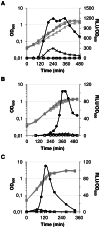Rgg-associated SHP signaling peptides mediate cross-talk in Streptococci
- PMID: 23776602
- PMCID: PMC3679016
- DOI: 10.1371/journal.pone.0066042
Rgg-associated SHP signaling peptides mediate cross-talk in Streptococci
Abstract
We described a quorum-sensing mechanism in the streptococci genus involving a short hydrophobic peptide (SHP), which acts as a pheromone, and a transcriptional regulator belonging to the Rgg family. The shp/rgg genes, found in nearly all streptococcal genomes and in several copies in some, have been classified into three groups. We used a genetic approach to evaluate the functionality of the SHP/Rgg quorum-sensing mechanism, encoded by three selected shp/rgg loci, in pathogenic and non-pathogenic streptococci. We characterized the mature form of each SHP pheromone by mass-spectrometry. We produced synthetic peptides corresponding to these mature forms, and used them to study functional complementation and cross-talk between these different SHP/Rgg systems. We demonstrate that a SHP pheromone of one system can influence the activity of a different system. Interestingly, this does not seem to be dependent on the SHP/Rgg group and cross-talk between pathogenic and non-pathogenic streptococci is observed.
Conflict of interest statement
Figures




Similar articles
-
Genetic and Structural Analyses of RRNPP Intercellular Peptide Signaling of Gram-Positive Bacteria.Annu Rev Genet. 2017 Nov 27;51:311-333. doi: 10.1146/annurev-genet-120116-023507. Epub 2017 Sep 6. Annu Rev Genet. 2017. PMID: 28876981 Free PMC article. Review.
-
Export of Rgg Quorum Sensing Peptides is Mediated by the PptAB ABC Transporter in Streptococcus Thermophilus Strain LMD-9.Genes (Basel). 2020 Sep 19;11(9):1096. doi: 10.3390/genes11091096. Genes (Basel). 2020. PMID: 32961685 Free PMC article.
-
Multiple length peptide-pheromone variants produced by Streptococcus pyogenes directly bind Rgg proteins to confer transcriptional regulation.J Biol Chem. 2014 Aug 8;289(32):22427-36. doi: 10.1074/jbc.M114.583989. Epub 2014 Jun 23. J Biol Chem. 2014. PMID: 24958729 Free PMC article.
-
Identification of Quorum-Sensing Inhibitors Disrupting Signaling between Rgg and Short Hydrophobic Peptides in Streptococci.mBio. 2015 May 12;6(3):e00393-15. doi: 10.1128/mBio.00393-15. mBio. 2015. PMID: 25968646 Free PMC article.
-
Peptide pheromone signaling in Streptococcus and Enterococcus.FEMS Microbiol Rev. 2014 May;38(3):473-92. doi: 10.1111/1574-6976.12046. Epub 2013 Oct 31. FEMS Microbiol Rev. 2014. PMID: 24118108 Free PMC article. Review.
Cited by
-
Interspecies communication among commensal and pathogenic streptococci.mBio. 2013 Jul 23;4(4):e00382-13. doi: 10.1128/mBio.00382-13. mBio. 2013. PMID: 23882015 Free PMC article.
-
A Quorum-Sensing System That Regulates Streptococcus pneumoniae Biofilm Formation and Surface Polysaccharide Production.mSphere. 2017 Sep 13;2(5):e00324-17. doi: 10.1128/mSphere.00324-17. eCollection 2017 Sep-Oct. mSphere. 2017. PMID: 28932816 Free PMC article.
-
Rgg protein structure-function and inhibition by cyclic peptide compounds.Proc Natl Acad Sci U S A. 2015 Apr 21;112(16):5177-82. doi: 10.1073/pnas.1500357112. Epub 2015 Apr 6. Proc Natl Acad Sci U S A. 2015. PMID: 25847993 Free PMC article.
-
Genetic and Structural Analyses of RRNPP Intercellular Peptide Signaling of Gram-Positive Bacteria.Annu Rev Genet. 2017 Nov 27;51:311-333. doi: 10.1146/annurev-genet-120116-023507. Epub 2017 Sep 6. Annu Rev Genet. 2017. PMID: 28876981 Free PMC article. Review.
-
A Bacterial Tower of Babel: Quorum-Sensing Signaling Diversity and Its Evolution.Annu Rev Microbiol. 2020 Sep 8;74:587-606. doi: 10.1146/annurev-micro-012220-063740. Epub 2020 Jul 17. Annu Rev Microbiol. 2020. PMID: 32680450 Free PMC article. Review.
References
-
- Schuster M, Greenberg EP (2006) A network of networks: quorum-sensing gene regulation in Pseudomonas aeruginosa . Int J Med Microbiol 296: 73–81. - PubMed
-
- Novick RP, Geisinger E (2008) Quorum sensing in Staphylococci. Annu Rev Genet 42: 541–564. - PubMed
-
- Fuqua C, Greenberg EP (2002) Listening in on bacteria: acyl-homoserine lactone signalling. Nat Rev Mol Cell Biol 3: 685–695. - PubMed
Publication types
MeSH terms
Substances
Grants and funding
LinkOut - more resources
Full Text Sources
Other Literature Sources
Molecular Biology Databases

